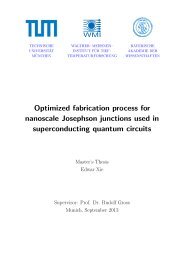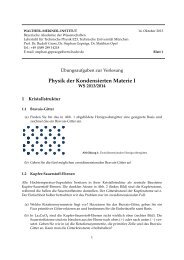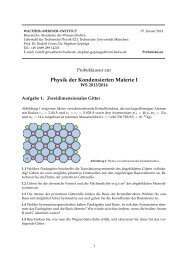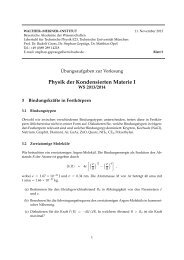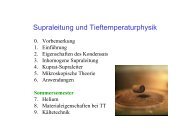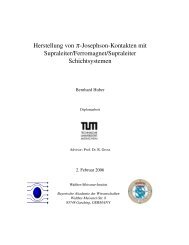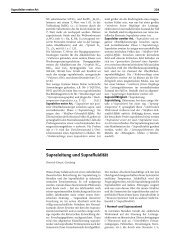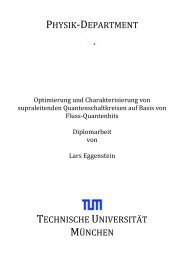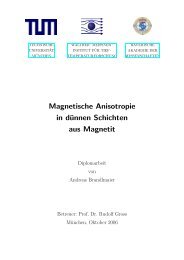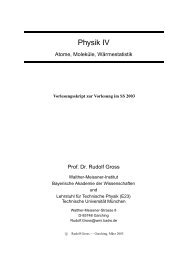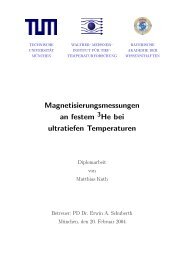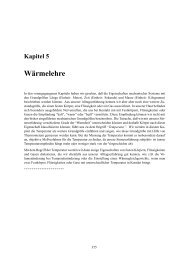Surface magneto-plasmons in magnetic multilayers - Walther ...
Surface magneto-plasmons in magnetic multilayers - Walther ...
Surface magneto-plasmons in magnetic multilayers - Walther ...
You also want an ePaper? Increase the reach of your titles
YUMPU automatically turns print PDFs into web optimized ePapers that Google loves.
Section 2.2<br />
Dispersion relation 9<br />
In metals the electrons can be treated as a free electron gas. The dielectric function<br />
for a free electron gas can be calculated with the Drude formula[28, 5], giv<strong>in</strong>g<br />
ε ′(1) (ω) = 1 − ne2<br />
ε0m∗ω2 = 1 − ω2 p<br />
ω<br />
2 , (2.17)<br />
with the electron density n, the elementary charge e, ε0 be<strong>in</strong>g here the vacuum per-<br />
meability and m ∗ the effective mass of the electrons, and ωp is the plasma frequency<br />
of metals,<br />
ωp =<br />
<br />
ne2 . (2.18)<br />
ε0m∗ With nAu = 5, 9 × 10 28 m −3 [29] the plasma frequency becomes ωp = 1.36×10 16 rad/s.<br />
Equations (2.17) and (2.15) can thus be rewritten<br />
k ′ x = ω<br />
c<br />
<br />
<br />
<br />
<br />
ε′(2)<br />
<br />
1 − ω2 <br />
p<br />
ω<br />
ε ′(2) <br />
+ 1 − ω2 (2.19)<br />
p<br />
ω<br />
This is the approximate dispersion relation for surface <strong>plasmons</strong> at a metal-dielectric<br />
<strong>in</strong>terface, where the complex part of the metal’s permeability is neglected.<br />
In Fig. 2.2 the dispersion relation for an air-gold <strong>in</strong>terface (ε ′(2) = 1) is plotted (black<br />
l<strong>in</strong>e). It splits up <strong>in</strong>to two branches with a forbidden gap <strong>in</strong> between. The upper<br />
branch becomes for kx → 0 equal to the plasma frequency ωp (upper green l<strong>in</strong>e) <strong>in</strong><br />
Fig. 2.2(a) and <strong>in</strong>creases for kx → ∞. Because ωp can be regarded as the plasma<br />
frequency of volume <strong>plasmons</strong> the upper branch describes the dispersion relation for<br />
volume <strong>plasmons</strong> [30]. The lower branch becomes zero for kx → 0. For kx → ∞ the<br />
dispersion relation ω approaches the surface plasmon frequency (lower green l<strong>in</strong>e).<br />
ωsp =<br />
ωp<br />
√ 1 + ε ′(2)<br />
(2.20)<br />
This is the limit<strong>in</strong>g case when the real part of the metal’s dielectric function ap-<br />
proaches the permeability of the dielectric ε ′(1) → −ε ′(2) . Or <strong>in</strong> other words the<br />
damp<strong>in</strong>g part of the metal ε ′′(1) can be neglected. With Eq. (2.18) and E = ω the<br />
energy of surface <strong>plasmons</strong> is <strong>in</strong> the order of Esp = 4.8 eV<br />
So <strong>in</strong> the case of kx → ∞ the group velocity (∂ω/∂kx) and the phase velocity (ω/kx)<br />
goto zero. Therefore, surface plasmon are localised longitud<strong>in</strong>al oscillations of the



